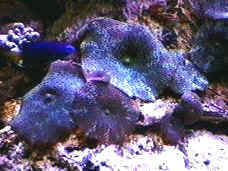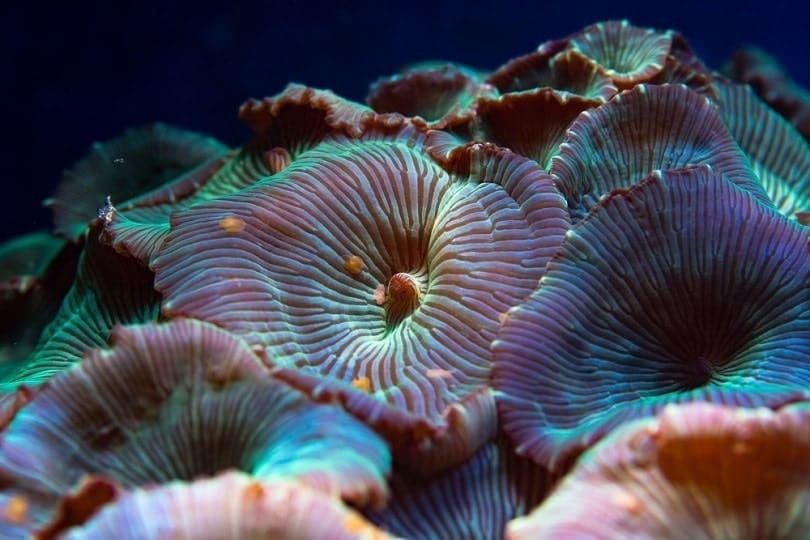
The Umbrella Mushroom can form a balloon shape and look like an umbrella turned inside out!
The Discosoma neglecta, most commonly known as the Umbrella Mushroom, is named for its obvious shape. This mushroom looks like an inverted umbrella, or a dome shape where someone pushed the center down. Yet the middle area is raised and tapers down to the edges.
Umbrella Mushrooms usually come in mottled patterns of green, brown, cream, and blue to purple, with the tentacles being the same color. Thus they are also known as the Caribbean Umbrella Mushroom or Mottled Mushroom. Rather than having long feeder tentacles, they have knobby tentacles, with some surface radial lines and bumps. The perimeter has spaced tentacle “points” which can give it a spiked appearance.
Though most mushroom corals stay put, the Umbrella Mushroom is capable of moving around and relocating. They will eat unsuspecting slow fish and crustaceans. All their tentacles have hold toxic stinging cells, but those perimeter tentacles actually may sting and can actually act as sweeper tentacles to capture prey.
The Umbrella Mushroom is very decorative and moderate to easy to care for. They are a bit more difficult than the Actinodiscus genus because they are not as tolerant of poor water conditions. D. neglecta can grow quite large, reaching 4″ (10 cm), yet they do tend to grow slower than Indo-Pacific Discosoma. They prefer dim light and a low water flow. Too much light and a higher water flow will actually cause them to shrink their size.
The D. neglecta propagates easily in captivity, which can contribute to preserving the wild populations. After splitting however, the clone mushroom doesn’t necessarily always resemble the “mother” mushroom, thus giving the aquarist a variety of shades and colors. They have very few predators if any.
Scientific name
Family: Discosomatidae
Species: Discosoma neglecta
Distribution / Background
Mushroom Coral Information: The Umbrella Mushroom Discosoma neglecta was discovered by Duchassaing and Michelotti in 1860. Some names they are known for are Caribbean Umbrella Mushroom or Mottled Mushroom. General names all Corallamorphs are called include Mushroom Coral, False Coral, Disk Anemone, Mushroom Anemone, Coral-like Anemone, False Anemone, and Jewel Anemone.
Where Mushroom Corals Are Found: The Discosoma neglecta are found in the Caribbean.
Mushroom Coral Habitat: These Mottled Mushrooms are found individually in areas where there is low light. They like to grow on dead corals, rubble, and between coral heads. They feed on small fish and crustaceans. The D. neglecta tend to grow slower than Indo-Pacific Discosoma. It propagates easily in captivity, which can contribute to preserving the wild populations. Yet after splitting, the clone mushroom doesn’t necessarily always resemble the “mother” mushroom. They have very few predators if any.
Status
The Discosoma neglecta is not on the IUCN Red List for endangered species
Description
What do Mushroom Corals look like: These Coral Mushrooms Discosoma neglecta are basically a coral without a skeleton and their internal structures are the same as stony corals. The top of their body or the upper surface is called the oral disc. The stalk area, which is very small, is called the column and it is located just above the pedal disc, which is where they attach to surfaces. Umbrella Mushrooms usually come in mottled patterns of green, brown, cream, and blue to purple, with the tentacles being the same color.
The D. neglecta looks like an umbrella turned inside out. It resembles a dome shape and someone pushed the center down, yet the middle area is raised and tapers down to the edges. They have an oral disc that is flat and rigid, but can form a long protrusion that they use to defend themselves. Rather than having long feeder tentacles, they have knobby tentacles, with some surface radial lines and bumps. Their perimeter has spaced “points” which can give it a spiked appearance. All their tentacles have hold toxic stinging cells, but those perimeter tentacles actually may sting and do act like a sweeper tentacle which aids in prey capture.
They can actually warp the surface of their oral disc to change the water flow over them to direct particulate and flocculent material toward their mucous center for absorption. At times they will make a trumpet shape. This is thought to be formed when they are needing nourishment, or if the light level is low, or is of low quality due to age.
Mushroom Coral Life Cycles: The Umbrella Mushroom can grow to 4″ (10 cm), but their life span is unknown.
Difficulty of Care
Mushroom Coral Care: The Umbrella Mushroom is moderate to easy to care for and does not like or need high levels of light, in fact, they prefer dimly lit environments. More light and higher water flow will cause them to shrink their size. They also cannot handle high water flow since it will prevent them from getting nourishment. They should be kept in shaded areas in tanks with high output lamps like Metal Halides. If they are not shaded, they turn all brown and fail to thrive, or will just float around the tank until they find a suitable spot or they have an unpleasant encounter with a pump.
Foods / Feeding
Mushroom Coral Feeding: The Umbrella Mushroom is a carnivore. In the wild, these corallimorphs feed on small fish and crustaceans. Most mushroom corals are also well equipped with nutritional alternatives for their well-being. They can derive nutrition from their symbiotic algae, zooxanthellae, that dwells within their tissues. They can also actually warp their surfaces to change the water flow over them to direct particulate and flocculent material toward their mucous center for absorption.
In captivity you can feed your D. neglecta pieces of shrimp, fish, pellets, and even flake. Depending on their size and your lighting, feed a few times a week or once a week. They are greedy feeders, you will know if they are hungry because they will grab the food.
Aquarium Care
Water changes of 10% bi-monthly or 20% a month are typical. Provide a reef environment with proper magnesium levels. Some claim proper iodine levels are beneficial also. Due to their toxins, active carbon is a good idea with larger colonies of mushrooms. Do not over skim since the D. neglecta need nutrients to survive on and will not do well in a pristine environment. However, they are not as tolerant to poor water conditions as the Actinodiscus genus.
Aquarium Parameters
A typical live rock/reef environment is what is needed for your Umbrella Mushroom. Provide rubble or dead coral and live rock for them to have something with which to attach their pedal disc. They do not do well with strong water movement, so direct the power heads and intake nozzles away from them. As they can float around when looking for a place to settle, it’s a good rule of thumb to have all of your pumps covered. Most good quality pumps have guards on them.
- Minimum Tank Size / Length: Nano tank of 5 gallons or more
- Marine Lighting: Low
- Temperature: 72° – 83° F (22° – 28° C)
- Salinity / Specific Gravity: 1.023 to 1.025
- Water Movement: Low / weak to moderate
- Water Region: MIddle to bottom of the aquarium
Compatibility and Social Behaviors
The Umbrella Mushroom is semi-aggressive if they are near another coral. They will cause other corals to loose tissue, recess possibly die. Do not keep with slow moving fish or crustaceans as they may become a meal to your D. neglecta. Acroporas will not grow in aquariums with large mushroom populations. Make sure to leave 6 – 8 ” between your mushrooms and other corals. Watch the growth rate since the D. neglecta will overgrow and kill any nearby corals.
Mushroom Anemones will tolerate their own species and usually other Mushrooms. In the wild many species of Mushroom Corals occur together in large groups. In captivity D. neglecta will get along with their own species, but may not tolerate mushroom species outside their colony. Even in one genus, if the color is different or a different species, the weaker mushroom will detach and find another location. Strong water movement will cause them to detach as well.
Sex – Sexual differences
No sexual difference in appearance is known.
Breeding and Reproduction
- Mushroom Coral Reproduction:
Corallimorphs reproduce in 4 different ways. The first three ways, asexual budding, laceration, and division/fission, are successful in the aquarium as most hobbyists soon discover. Budding is where individuals are formed from particles divided off from the pedal disc. Similar to budding, laceration happens when they move slowly over the surface and leave behind small pieces that will eventually form into mushrooms. Division or fission is where an individual divides down the center and forms two animals.
Sexual reproduction is where eggs and sperm are released into the water column. They unite and form free-swimming larvae which are initially plankonic, and them settle and adhere to the substrate. Sexual reproduction has not been well documented, and has not been observed in captivity. Presumably modern filtration methods are inhospitable to free swimming larvae. - Mushroom Coral Propagation:
Mushroom corals can be easily propagated in captivity by cutting individual polyps into several pieces. Placed the pieces on a gravel substrate with low water flow. They will attach themselves to pieces of gravel. Later they can then be super glued to a suitable substrate such as a reef plug. It has been stated that the warmer end of their temperature spectrum encourages reproduction.
For details on how to propagate your mushroom corals see Mushroom Corals: Mushroom Coral Propagation
Potential Problems
The D. neglecta are disease resistant, and only affected by improper husbandry. Problems for the most Corallimorphs are pretty minimal unless your lighting, water movement, feeding and water quality are improper for these animals. A sign of this is if your coral mushroom detaches to look for “better conditions” to settle in. They have very few predators if any.
Availability
Mushroom Corals for Sale: The Umbrella Mushroom, Caribbean Umbrella Mushroom, or Mottled Mushroom D. neglecta can be found easily online and at pet stores, as well as from frag farmers and most reef clubs. Online they start at about $15.00 USD for a single polyp, or more depending on if they are sold in a colony or not.
References
- Animal-World References: Marine and Reef
- Eric Borneman, Aquarium Corals : Selection, Husbandry, and Natural History , TFH Publications, 2001
- Anthony Calfo, Book of Coral Propagation, Volume 1 Edition 2: Reef Gardening for Aquarists, Reading Trees; 2 edition, 2007
- Ronald L. Shimek, Guide to Marine Invertebrates: 500+ Essential-to-Know Aquarium Species, Microcosm, 2005
- Julian Sprung, Aquarium Invertebrates, Advanced Aquarist’s Online Magazine, Copyright 2002
Featured Image Credit: IanRedding, Shutterstock
